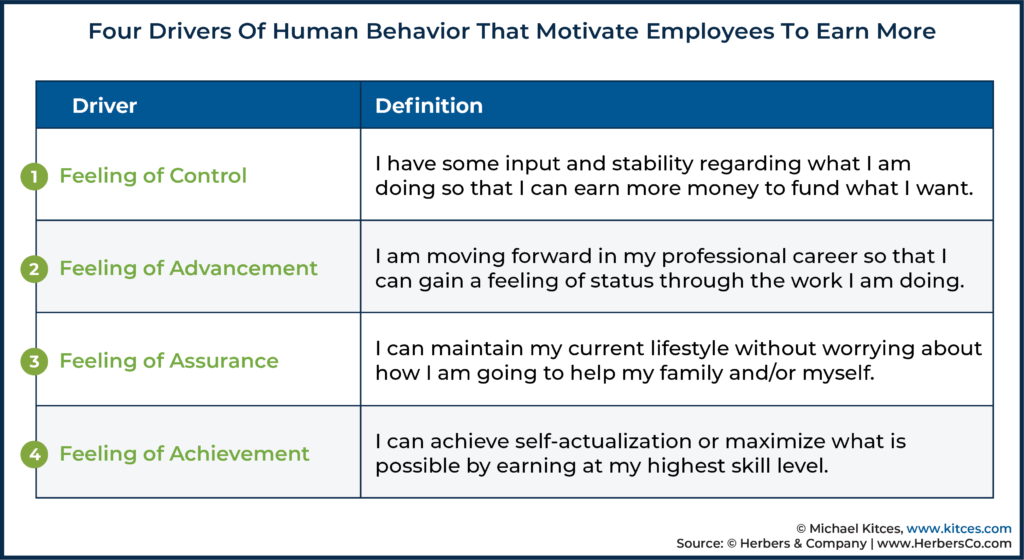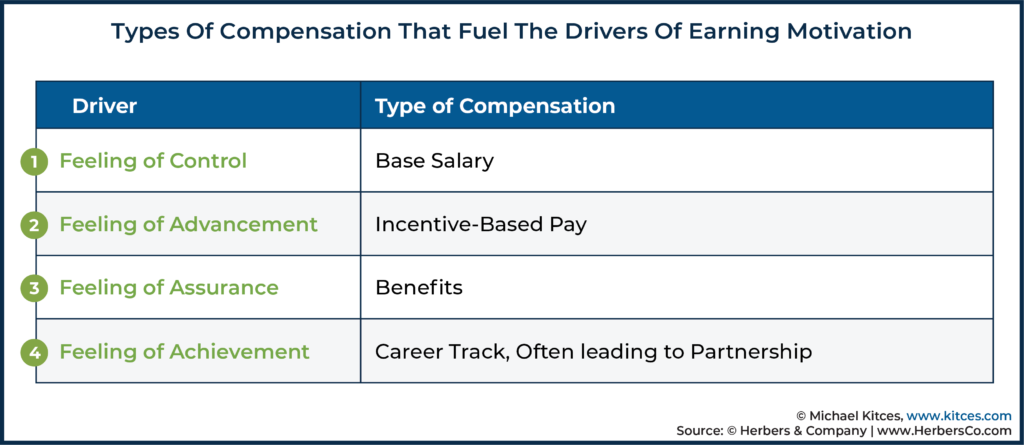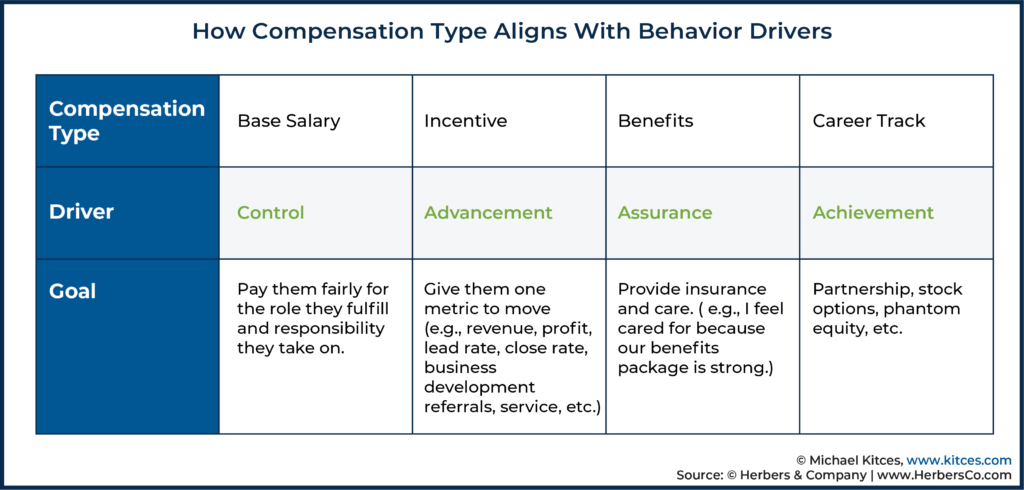Executive Summary
Human beings respond to incentives, and as a result, compensation is one of the most influential drivers of employee motivation and is often used by employers as a way to guide their team’s behaviors. For example, some employers design their compensation structures to reward employees for experience gained and/or length of service provided to the company, or by adjusting an employee’s pay to compensate for certain benefits (e.g., paying extra to cover health insurance costs when the company has no group insurance plan, or by reducing pay to compensate for retirement plan contributions the company makes on behalf of the employee). Very frequently, though, employers overlook the fact that it is not actually the money itself that influences their employees but, rather, it is what the money offers to or makes possible for the employee that matters most. And it’s those emotional connections to money that ultimately must be tapped effectively in order for compensation incentives to actually create the desired business outcomes.
In this guest post, Angie Herbers – Chief Executive and Senior Consultant at Herbers & Company, an independent management and growth consultancy for financial advisory firms – identifies the common mistakes that many financial advisory firms make in developing their compensation models, and also discusses four key drivers behind the money that actually motivate employees. And that by understanding the different types of compensation that address the needs of specific motivational drivers, advisory firms can design better compensation models that will not only save time, but will also enhance the firm’s culture!
There are four common mistakes that advisory firms tend to make when creating their compensation structures. The first is designing an incentive structure without a clear focus – or with a focus on too many objectives – as many firm owners try to tie too many metrics to compensation (e.g., revenue, and profit, and client service) rather than on prioritizing one main objective with a clear focus (and a better chance of meeting that objective) for all. A second mistake is using compensation as a way to adjust for benefits; either increasing pay to make up for benefits the company does not offer (e.g., higher pay for no health insurance… but then what happens if the firm adds health insurance later?) or reducing pay to compensate for benefits the company does offer (e.g., reduced pay in exchange for employer contributions to an employee’s retirement plan… that the employer was probably going to make anyway for their own benefit!?). A third mistake that firm owners make is offering partnership rights as a form of compensation (i.e., not paying partners a salary for their active role in the business, and letting net partnership distributions be the primary or sole compensation), as the income a partner receives for ownership and what an employee receives for work in the business reflect two very different functions. And the last common mistake is neglecting to update the compensation structure over time, which should be reviewed and updated often to respond to the behaviors that the firm wants to influence (as the needs and demands of the business itself do tend to evolve over time as well).
When it comes to the actual drivers that make employees want to earn compensation, there are four basic feelings that serve as central motivators, and certain types of compensation offered can generally serve to satisfy these feelings for employees: 1) control (regular base salaries that employees can rely on receiving for the role they play in the company), 2) advancement (incentive-based pay that gives employees a sense that what they do is helping them advance through the ranks), 3) assurance (benefits offered to convey that employers care about their employees and are taking measures to provide care for them), and 4) achievement (compensation tied to a career-track plan). And for employees to develop trust in their employers, they need to have at least some of these feelings satisfied by the compensation they receive for the work that they do.
Ultimately, the key point is that if employers take the time to analyze their teams’ compensation needs, and decide which of the four motivational drivers are most important to their employees (and it may be the case that all four are important to a firm), firm owners can better understand which compensation structures would be most beneficial to implement, and why. And when effective compensation structures are in place that satisfy employees’ motivational needs, the result often produces more streamlined employee management… not to mention inevitably enhancing the firm’s culture and overall morale, as well!
Charlie Munger said it best: “Show me the incentive and I will show you the outcome.”
In business, wherever the money goes, behavior will follow. Unfortunately, while that may be true, it also doesn’t necessarily mean that money’s influence on behavior will always have good results. Incentives have been known to inspire everything from record-breaking growth to unethical choices to just plain old confusion among employees. In other words, incentives may guide behavior, but if the incentive isn’t designed properly, it may not incentivize the behaviors that the firm actually desired.
Today we are going to talk about how you can build a compensation system that incentivizes the behavior you want in your team. To begin, let’s look at a few of the mistakes advisory firms make when it comes to compensation.
Four Common Compensation Mistakes Made By Financial Advisory Firms
Among all of the advisory firms that Herbers & Company has consulted over the years, there are four common mistakes about how to approach staff and advisor compensation that have come up time and time again.
Mistake #1: Diluted Focus
When it comes to the good things in business, advisors typically want it all at the same time: high revenue, high profits, and high valuations. Sounds great, right?
Of course, you want all those things to improve (revenue and profit and valuation of your business), but asking for an employee to be responsible for increasing them, all at the same time, is a tall order!
When we help advisors, it actually sounds more like, “I need an incentive structure for our advisory team that gets them to do business development and bring in new clients and give great service to existing clients and to agree to use more technology and that rewards them for any other advisor they bring into the team and that rewards them for being productive… all subject to my opinion of their performance, of course.”
Well, good luck. Having an incentive structure that focuses on everything doesn’t actually incentivize all the behaviors at once; it’s simply a dilution of focus. Doing so is like having one spaceship and trying to approach multiple stars at once; by aiming for all of them, you won’t actually reach any of them.
In other words, by telling the team to focus on being good at everything, in reality, it divides their focus, and consequently, no one is actually focusing on anything.
The solution, of course, is to choose one single north star to aim for. Not that the other behaviors are expected to fall by the wayside – they’re still part of the job – but the whole point of having incentives to encourage particular behaviors is that something has to actually be a priority over the others.
When I look at the compensation structures of advisory firms, my first question is, “Is this structure pointing to the strategic metric that we’re trying to move?”
If it’s not, the first step is to decide what is the most important metric we are going to try to move. Is it revenue or profit?
If you’re a growth company, then you’ll want to focus on building something to incentivize increasing revenue.
If you’re more like a value company, you are more likely to choose to focus on maxing out your profit margins and subsequent shareholder dividend distributions.
Mistake #2: Higher (Or Lower) Pay To Compensate For Lack (Or Availability) Of Benefits
I have heard countless times advisory firm owners who say, “We don’t have medical benefits, but we pay our employees $200 per month (or so), so they can afford their own insurance,” and/or “We don’t have a retirement plan, but employees really should contribute to a Roth IRA anyway.”
The problem with the ‘reimbursement method’ of doing benefits is that it is designed as an area that everyone shares equally and, in many cases, not dependent on one’s position in the company.
What happens is that employees will start negotiating benefits like they do their salary. Then, firms end up with one employee getting paid, say $200 per month, and another getting paid $600 per month, each to cover their respective medical expenses. Then, when you do add benefits in the future, what do you think employees will do when you take away $200 each month from one employee and $600 from another to replace it with the actual benefits?
This issue of mixing up benefits and pay also happens with retirement plans. Only it’s not increasing compensation; it’s decreasing it. Instead of making the benefit a true benefit, firms instead decrease their employee pay by however much they want to contribute to the retirement plan.
Though it’s not said out loud, the firm’s thinking goes something like this: “We have a SEP, and we’re contributing $10,000 for you every year, so we will decrease the base salary in the Offer Letter for the new employee by $10,000, and explain that they’re getting a fair ‘total’ compensation including the retirement plan benefits.” Employees aren’t stupid – especially at financial advisory firms. They know that often the only reason you have a retirement plan for the business is to minimize your own company taxes for long-term wealth maximization. In which case they’re really just being paid a below-market wage when it comes to the monthly cash they earn to actually pay their near-term bills.
Years ago, I interacted with a firm that was struggling with bad turnover. I looked at their compensation plan, and they had what would be considered (by industry standards) to be really low base salaries. When I asked why, they pointed to their SEP contributions.
When their employees were asked how they felt about the SEP, most of them said they didn’t care about it. One, in particular, said, “My wife just had twins, and we need to buy a new house, so I would much rather have that money in my checking account right now. At the least, what I want is a choice.”
Advisors know tax planning really well, so they often start getting creative with their staff compensation plans to minimize taxes, and often they mess with the benefit structures. And that’s fine, but be careful that in the process of playing a game with the government, you don’t end up limiting your employees' options.
Simply put, there’s a danger of designing compensation plans where the objective starts to become more about your own tax return than the health of your business and the happiness of your employees.
Mistake #3: Mistaking Ownership For Compensation
Many advisors will give new ‘junior’ partners partial ownership in the firm… and then proceed to decrease their base salary because now they can receive a distribution on the company’s profits as income instead.
It’s true that partners receive dividends, but what is more important is that the dividend should represent their shareholder status, not serve as a substitute for the income they receive for the role they play in the company itself!
When you start commingling partnership with employee compensation, you’re lumping together two very different roles. The dividend is for the shares they bought or received in your company, and the compensation is for the job they do as an employee. Those two things are not the same; accordingly, your compensation plan should not treat them the same.
Mistake #4: Setting It And Forgetting It
At Herbers & Company, we would rather not create compensation structures that are designed to be singular, fixed projects for firms we work with. Instead, we prefer to develop a flexible compensation model, help the firm implement it, and as we see the behaviors move in the organization as a result of it, to respond and continually tune the structure based on that feedback and behavior changes.
To be clear, this is not changing the compensation structure itself and moving the goalposts for the employees. This is making slight enhancements to an existing compensation structure, such as layering on bonus incentives and/or slight increases in percentage payouts and ratios to make the incentive even more in line with the business vision.
But a lot of advisory firm owners will set up a compensation structure and then wash their hands of it as though it is done for eternity. Compensation structures are an ongoing, never-ending process for a firm and should be tweaked and reviewed often based on the current reality of doing business.
Look at the pandemic as an example. We worked with many firms that were running on revenue-based incentive structures going into the pandemic. The pandemic hit, the market tanked, and we instantly tuned those revenue structures to include a slight increase in the revenue bonus so employees would continue to focus on growth, bringing in new clients, and generating client referrals. In some of our firms, we layered on a one-time bonus if an employee brought in a client referral that closed (specifically to help offset the revenue decline of the pandemic at the time).
Now that you understand these common mistakes, it’s important for us to talk about the role of behavior in designing a compensation plan.
The Four Drivers of Human Behavior to Build Your Compensation Structure Around
The basic truth that you must understand about compensation is that compensation structures, in and of themselves, do not actually motivate anyone – it’s what is behind the money that motivates.
If an employee wants something, they are going to do what they can to get it. And, often, those wants require money. Maybe it’s the house they want to buy, their upcoming wedding they want to fund, or even releasing the worry of saving for their own retirement. If money for money’s sake alone was truly the primary motivator, they would just hoard all of it and never spend it, which is actually quite rare.
With that truth in mind, here are the four drivers of human behavior that are the actual motivators behind why employees desire higher compensation. These motivators were developed by Herbers & Company using twenty years of experience working, surveying, and talking with thousands of employees at advisory firms, and we’ve learned most compensation drivers fall in one of these four categories.
In order to develop trust with an employee, you need to meet some or all four of these needs across your advisory firm culture and through your compensation structures. Different employees are driven by different feelings, and when you are able to hit all of them, you are more able to hit the needs of all employees. When you have all of the drivers at play in your compensation models, it helps to meet all of the 'feeling' needs of all employees. This will also help firms retain talent and have employees perform at their greatest level.
Focusing on employee needs often results in employees delivering great performance, which will then fill the business revenue and profit needs.
Compensation has the power to fulfill all four of these feelings and/or take all of them away. As a leader, you have to ask yourself how you are going to give your people the feeling they are seeking through their compensation structure, so they stay within your culture, and so they maximize their contribution toward it.
Numbers on a spreadsheet do not make a great compensation structure if your employees don’t feel they’re on track regarding at least one of the above feelings. Compensation isn’t just about feeling good about what you earn. It’s about feeling good about what you are earning within the place you are working to move towards the desired outcomes that drive you.
If earning feels like … well, nothing – that is to say, an employee’s paycheck doesn’t elicit any of the feelings that motivate an employee to earn more – no employee will stay at your firm regardless of how great their compensation numbers look on a spreadsheet!
These feelings that drive an employee’s desire to earn more can even be associated with actual types of compensation methods used, as indicated below.
Here’s an example of how this works. If you are paying all your employees a base salary and you offer no incentive-based pay, benefits, or career track toward ownership, you are only facilitating your employees' feelings of control within your culture. Therefore, anyone who desires advancement, assurance, or achievement more than control will likely fight for one or all of the other types of compensation and/or one day leave your firm to find another opportunity where they can achieve their desired outcome. Not all firms will be able to implement all compensation types immediately. The goal is to offer a mix of all four compensation methods to meet all the desired feelings and to build upon those drivers as your business grows.
To put it all together, the following table shows how compensation types line up with drivers and how you can satisfy each need for your employees with different types of compensation to create a flourishing and growing culture within your firm.
How Focusing on Motivational Drivers Improves Employee Management
If you get really clear on how to manage all four needs of employees in your firm through the development of compensation structures that hit all the drivers over time, you will be able to enhance the management of your culture by meeting your team’s needs:
- The feeling of control will reduce the need for employees to come to you to negotiate salaries and/or try to control your decisions (e.g., they won’t consistently ask for more money.)
- The feeling of advancement will motivate the whole team to work together toward moving the same metric and having the compensation tied to the metric you are trying to move.
- The feeling of assurance will help employees feel they no longer need to tear themselves apart, worrying about how they are going to make their own financial plan work for them. Instead, employees will feel protected.
- The feeling of achievement will raise confidence that team members are part of something bigger than themselves.
There are countless articles out there on emotional intelligence and how important it is to create a stable workplace emotionally. When you have a good compensation structure, incentive structure frameworks, and benefits, people who are emotionally sound will be attracted to your firm because you care … about their feelings. And when this happens, emotional stability will naturally develop on its own in the workplace.
When you give people that sense of direction and clarity, you eliminate a host of questions otherwise directed at management: When do we get raises? When do we get reviews? What kind of raise should everyone get? How do we fit into the culture? When do we become partners? What are my options to grow?
While many advisory firms believe compensation structures are a static set of numbers on a spreadsheet, the reality is that compensation structures are a feeling. If the reward that employees receive for the work they do does not feel good to them, it’s a sure sign that the firm will have high management needs of people.
If those feelings aren’t managed through the development of compensation plans that cater to what people generally want to feel, no compensation will make them feel good. In other words, enough will never be enough.
The bottom line is that compensation begins with understanding the behavior you want to generate and knowing the feelings that are associated with them.
The irony is that this is an industry about money, and business owners in this industry often start with the money. But as you know, from working with clients, it’s the feelings that really drive the behavior.
Peace of mind can hardly come from just a spreadsheet; rather, it comes from great [compensation] planning!







